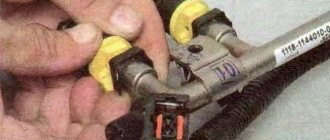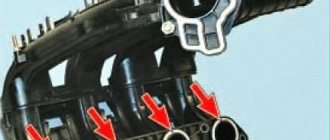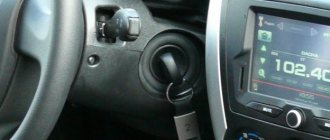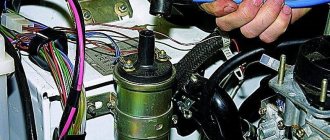Have you encountered engine problems when the car stalls in traffic jams or the engine speed is unstable? There may be several reasons for these malfunctions. It is recommended to start searching for a problem with diagnostics, and if this is not possible, then first perform a check, and only then change the faulty parts.
AvtoVAZ installs the same type of engines on modern Lada cars (Kalina, Granta, Priora, Largus, Vesta, Niva or XRAY), so the solution to problems for all these cars is similar.
The idle speed fluctuates, the engine stalls when moving (on the move) or at a standstill, the reasons may be the following:
- The engine air filter is clogged.
- The spark plugs are faulty.
- High voltage wires are faulty.
- Ignition module/coils are faulty.
- The idle air control (IAC) or its electrical circuits are faulty.
- The throttle position sensor (TPS) is faulty or the throttle assembly is dirty.
- The mass air flow sensor (MAF) is not working.
- The oxygen sensor (OS) or circuits are faulty.
- There is insufficient pressure in the fuel rail.
- Compression in the cylinders is low.
- The exhaust system is leaking.
- Air leaks through the crankcase ventilation hoses and the hose connecting the intake pipe to the vacuum brake booster.
- The cylinder head gasket is damaged.
- The timing belt or tension roller is worn.
- The camshaft cams are worn.
- The valve timing is off. Check the alignment of the marks on the crankshaft and camshaft.
- The engine control unit (ECU) or its circuits are faulty.
Have you encountered floating engine speeds? What was the cause of the malfunction? We solve such engine problems in the comments or on the forum. Let us remind you that along with unstable speed there may be other problems, for example, the engine is difficult to start.
The Lada Kalina idle speed sensor or IAC is a device that is responsible for the necessary air supply to the internal combustion engine when it is idling (in the absence of pressure on the gas pedal). For example, the driver releases the accelerator pedal and the air supply to the internal combustion engine stops. To prevent the engine from stalling, the idle speed sensor comes into operation, which is involved in the process of supplying the required amount of air bypassing the throttle assembly.
In other words, the IAC is a kind of valve-regulator. It is very important for every car owner to know and understand the principles of operation of the product, because if it breaks down, in most cases the car’s self-diagnosis system does not determine the reason for the incorrect operation of the engine.
If the engine is unstable or the engine stalls
| After starting, the idle speed of the engine should gradually decrease, and after a certain time it should completely return to normal. If the engine speed floats (unstable) immediately after starting or after warming up, then this is a malfunction that should be eliminated. |
The engine is running erratically:
- Low engine speed at idle (floats) or stalls.
- The engine stalled while driving.
- High engine speeds.
| Possible cause of malfunction | Checking (diagnosis) of a malfunction | Troubleshooting methods |
| Faulty spark plugs | Candles are checked at a special stand; it is impossible to check their condition at home. | Replace the spark plugs (see which spark plugs to choose). |
| Damage to the insulation of high-voltage (HV) devices | (Carburetor) Secure the end of a known-good high-voltage wire at a distance of 5–8 mm from the vehicle ground. Crank the crankshaft with the starter without touching the high-voltage circuits. A spark should regularly jump between the wire and ground. If there is no spark at the terminal of the ignition coil, the coil is faulty; if at the terminal / terminals of the ignition distributor, the rotor or distributor cap is faulty. Burnouts of the rotor or cover are determined visually. The serviceability of the rotor resistor (1 kOhm) is checked with an ohmmeter | (Carburetor) Replace the coil. Clean the distributor cap and rotor from dirt and moisture, replace the burnt-out rotor resistor; if you suspect an insulation breakdown (burnouts, cracks) of the rotor and distributor cap, replace them. (Injector) Replace the module or ignition coils. Replace the high-voltage wires (see which ones in / select wires). |
| The valve timing is off | Check the alignment of the marks on the crankshaft and camshaft. | Establish the correct relative position of the shafts (according to the marks). |
| The gap between the spark plug electrodes is not normal | Check the gaps with a feeler gauge. | Set the required gap by bending the side electrode, or replace the spark plugs (see which spark plugs to choose). |
| Heavy carbon deposits on spark plugs | Visual inspection. | Clean the spark plugs. Identify and eliminate the cause of soot formation. If necessary, replace the spark plugs (see which spark plugs to choose). |
| Low compression in the cylinders (wear or damage to valves, seats, wear, sticking or breakage of piston rings) | Check compression in cylinders. | Replace rings and pistons. Cylinder repair. |
| Increased resistance to air flow in the intake manifold | Check the engine air filter and intake manifold for dirt. | Clean the inlet pipe. Replace the engine air filter (see modification of the filter mount). |
| The engine control unit (ECU), its circuits, throttle position sensor (TPS) or injectors are faulty. | Check the presence of 12V on the ECU, the operation of the injectors, electrical circuits and sensors. | Replace the faulty unit (see ECU interchangeability), clean the throttle assembly, check the wiring. Clean the injectors or replace them with new ones (see which injectors to choose). |
| The control impulse from the DPKV arrives at the wrong time due to delamination of the crankshaft damper (the gear has moved relative to the pulley) | Visual inspection of the damper. | Replace damper. |
| The idle air regulator (IAC) or its electrical circuit is faulty | When starting the engine, lightly press the gas pedal, opening the throttle slightly. If the engine starts, but stalls when the pedal is released, the IAC is faulty (see checking the IAC). | Repair the IAC or replace it (see which IAC to choose) |
| Wear of camshaft cams/shafts | Visual inspection. | Replace camshaft. |
| xn--2111-43da1a8c.xn--p1ai |
Let's sum it up
Having completed the assembly process, we check the correct functioning of the valve-regulator on the LADA Kalina car. If the idle speed is within the specified limits, then the device is installed correctly, and no third-party air leaks are observed in the intake system.
The Lada Kalina idle speed sensor or IAC is a device that is responsible for the necessary air supply to the internal combustion engine when it is idling (in the absence of pressure on the gas pedal). For example, the driver releases the accelerator pedal and the air supply to the internal combustion engine stops. To prevent the engine from stalling, the idle speed sensor comes into operation, which is involved in the process of supplying the required amount of air bypassing the throttle assembly.
In other words, the IAC is a kind of valve-regulator. It is very important for every car owner to know and understand the principles of operation of the product, because if it breaks down, in most cases the car’s self-diagnosis system does not determine the reason for the incorrect operation of the engine.
Fuel supply faults
It is quite easy to find out that the car stalls while driving due to the engine being “choked” with the fuel mixture - during a long drive you will find that the signal of the sensor responsible for this function is constantly on.
Here the problem lies in low-quality fuel, which does not quickly “ignite” from the spark of the candles. It can also be caused by gasoline not meeting the requirements for the octane number specified in the vehicle specifications. If there are problems with fuel, the gas pedal will be pressed all the way, and the car will not begin to gain speed. In addition, the car will periodically stall when the clutch is engaged.
Another symptom indicating problems with fuel is the appearance of problems with the car after refueling. The problem is characterized by a rapid drop in engine power at full speed, as well as when constantly changing gears. The way out of the situation is to completely drain the bad fuel mixture, wash the engine and all the fuel system pipes.
- Dirt in the fuel filter;
- Problems with injector nozzles;
- Dirty throttle valves;
- Fuel pump power failure.
The main symptom of a malfunction of these parts is that there will be a gradual drop in the power of the car’s engine, after which the car will stall even after sharply pressing the gas pedal. If you do not release the clutch carefully when changing gears, this will also cause the engine to stall.
The contamination of the fuel filter and fuel pump can be judged by the unstable operation of the machine even during idling and during rapid braking (when the supply of the fuel mixture decreases). And if the performance of fuel filters can be easily established during an external inspection and eliminated by replacing them, then to detect other causes, you need a full-fledged computer diagnostics, which can only be carried out in a car service center.
Another reason for a stalled car associated with the operation of the fuel pump is boiling gasoline in the fuel pump. This happens mainly in hot weather when the car is moving slowly or standing on the highway in traffic jams. The car will start to stall while driving, but when you turn on the idle speed and press the clutch, it will start again.
If boiling occurs, it is better to stand in a traffic jam with the engine turned off and gradually cool the car. After 5-10 minutes, the car's operation will be stable again.
Examination
3 popular ways to diagnose the causes of a malfunction
Among professionals and car enthusiasts, there are many ways to check the performance of the sensor. But we will dwell in detail only on the most effective and simple methods:
- First method. The point of this method is to check the operation of the sensor itself. To do this, you need to remove the product from its mounting location, take it in your hand, connect the power contact block to it (if it is not connected) and start the car engine. In this case, on a working device, when the engine starts, the sensor needle should extend. If this does not happen, then its operation is impaired or the device is faulty.
- Second method. Assumes the use of a voltmeter. The task is to check that the correct voltage is supplied to the sensor. To do this, the sensor is disconnected from the contact chip, and a measuring device is connected to its terminals. After which, the ignition is turned on, and all the terminals of the contact chip are analyzed one by one. The operating resistance parameters should be about fifty ohms or tend to infinity. The voltage level should be 12 volts. If the voltage reading is less, this indicates improper operation of the battery or the cause is related to an open circuit or operation of the computer.
- The third approach involves checking the resistance of the external and internal windings of the sensor. Measuring work should be done using a multimeter. The contact parameters after measurements should be in the range from 40 to 80 Ohms. If there is a deviation or zero values of the device during measurements, the IAC must be replaced.
Electrical equipment
The problem of stopping the engine may also be due to a malfunction of electrical equipment. In particular, oxidation may occur at the battery terminals. Whether old cars or new ones, they all need maintenance and careful care. Consequently, the contact deteriorates as the resistance increases, and this leads to the engine stalling. The battery itself may also fail. In the same case, if the generator does not produce the required current, the entire electrical network of the car switches to power from the battery. If you do not immediately see a light on, indicating that there is no charging, the car will continue to move. Given that the lights are on and the ignition system is running, after a while the battery will be completely discharged and the engine will stop. You will have to charge the battery and also completely repair the generator.
It often happens that a seemingly working car for some reason stalls while driving. This is a rather unpleasant situation, especially if you have already started driving in quite busy traffic. This fact not only irritates the driver himself and everyone who thinks that he simply does not know how to drive. In addition, this can create a dangerous situation on the road.
It usually happens that the car stalls while driving, and then starts
The first two or three times drivers may not pay attention to this fact. But if this phenomenon has become permanent, you should definitely figure out why the car stalls while driving
As a rule, it is quite simple to identify the true cause, and even a driver who does not have deep knowledge in the field of auto mechanics will be able to understand the reason for the incorrect behavior of his car.
So, what are the most common causes of an engine stalling while driving, and what to do in this situation, we will try to figure out further.
Car exhaust system problem
The engine may also stall if the tubes responsible for removing gases are malfunctioning. At full speed, the car will quickly begin to “choke”, and pressing the gas pedal completely stops the engine. Malfunctions in the operation of the exhaust pipe system in 90% of cases are caused by contamination and clogging of the muffler. However, the catalyst may also fail.
In the first case, carefully clean the muffler and remove foreign objects from there. If there are problems with the catalyst, conduct a complete diagnosis of the exhaust system and replace this element.
Lada Kalina Hatchback › Logbook › Speed jumps, car stalls
Last winter I suffered with electrical problems, the speed dropped, the car stalled, both at idle and when driving, the Chinese adapter gave an oxygen sensor error, replacement (1400r), alas, did not correct the situation. 1. Diagnostics at service station No. 1 (FREE) the electrician fiddled around for two hours, checked everything he could, but couldn’t find the reason - drove for a week without problems 2. Diagnostics at service station No. 2 (500 RUR): reset the onboard errors, advised to adjust the valves - the car is working properly worked for two weeks 2.2 On the advice of a diagnostician, I went for an adjustment (750 rubles), low compression on the second cylinder, replacement of valves was recommended 3. Diagnostics at service station No. 3 (1000 rubles) we looked for the cause for about an hour, tightened the terminal of the oxygen sensor - rolled it for two weeks. After reading the forums, I tried to remove the terminal from the sensor on the air filter (mass air filter) - the speed has leveled off, it stopped stalling, I think this is the cause of my disasters, I buy a new mass air flow sensor (1700r), connect it and... F... the car just stalls. I think where to go next, to a church or a vacant lot to burn this devilish four-wheeled vehicle. 4. Diagnostics at service station No. 4 (500 rubles), after computer diagnostics the electrician says the oxygen sensor is faulty, they say there are a lot of defects now, I go buy a sensor (1400 rubles), install it, the problem does not go away, I leave the car at the station. Call in 4 hours - come. The electrician, angry as hell, reports that he climbed it up and down (threw the ignition coil, changed the spark plugs, armored wires, cleaned the damper) but it didn’t help at all, he suggested adjusting the valves, and his ambassador went to the garage to change the valves. Over the course of four days (three hours after work), under the strict guidance of a self-taught classmate and a simple tool (drill, fuel hose, a pair of keys and a set for removing/installing valves), I changed all the bushings, valve stem seals, valves, pump and a set of sprockets ( if I'm not mistaken for everything in photo No. 4 + set and paste (lapping) 3800 rubles). Result: we restored the compression, but the car still stalled. I remember the electrician from service station No. 3, he tried to run wires from the control unit directly to the sensor when he checked the wiring, he didn’t find the problem then, for how long in the car I tried to change all the spare parts that could only be related to the operation of the engine, I began to inspect the wiring and then I found something funny fact: the oxygen sensor is not connected to the unit directly, the wires go to the rack, and then an extension cord (photo No. 9) I’m buying a new one (80 rubles) and I can’t believe my luck, the car is working stably, a year has passed, no complaints.
The failure of the power unit to operate when cold or after warming up to a certain temperature may indicate a fairly wide list of possible problems. The engine begins to stall both suddenly and to work unstably in different modes, after which the internal combustion engine stops.
In this article we will talk about the reasons why the engine stops at idle, as a result of which a warm engine stalls, why a car with a hot engine stalls while driving, etc.
Read in this article
As you can see, there are many reasons why the engine stalls when hot. In some cases, the engine starts normally when cold and warms up, but after pressing the gas pedal the speed drops and the car stalls.
Advantages and disadvantages of an electronic pedal
- Instant engine response when you press the gas pedal.
- Smoothing out sharp gas changes.
- Reduced fuel consumption.
- Environmentally friendly.
- Non-repairable.
- Slower acceleration.
- Softer pedal.
What do you think about the electronic gas pedal on Lada cars? Maybe it would be better if the gas pedal has a cable? Let us remind you that some problems with E-Gas are solved after replacing the brake pedal position sensor.
Keywords: granta fret pedals | Lada Priora pedals | fret Kalina pedals | 4x4 pedals | fret vesta pedals | pedals lada xray | fret largus pedals | Niva pedals | universal article
Share on social networks:
Found an error? Select it and press Ctrl+Enter..
Lada Kalina starts and immediately stalls. Cause and solution to the problem.
I'm talking about a glitch with the Lada Kalina. Like a car that doesn’t want to start on a dead battery. The reason is the immobilizer. View to all Kalinovodas. A very scary situation. There is also a problem with starting it by lighting it from another car. Immobilizer lags on AvtoVAZ Lada Kalina.
Aidyn QazaQ Khany 6 개월전
like you friend. changed the battery and started.
Sasha Malina 6 개월전
I've been racking my brains for half a year, and here it's just you
Machinist 10 개월전
What the hell does this have to do with the battery? My battery was dead. After a day of standing, the starter could barely turn, but when it caught hold, it started and rumbled steadily. Now there is another grant, the starter turns vigorously even after a week of standing. But with the onset of cold weather, glitches began when cold - it starts, rumbles for 1-2 seconds and stalls, but the second time everything is ok. This is 100% not about Akuma. It seems to me that the dog has rummaged around with one of the relays, the gasoline relay is surrendering to me. This is due to a power loss during startup, causing the relay to turn off the fuel pump.
Machinist 8 개월전
Mikhail Velikorodny is good.
Mikhail Velikorodny 8 개월전
Driver I have the same problem! If you find a way, let me know! Thank you in advance !
777jj555zlo
100% right!! low voltage and the standard emobilizer will work, it turns off or prevents the car from starting, clean the ground on the contact body, lubricate the terminals, charge the battery
SEARCH ENGINE 63RU
did you try to start it in emergency mode? so at least you can get home)
Throttle valve
Very often the engine stalls due to the throttle. This happens due to contamination of its surface, which in turn occurs due to a malfunction of the air filter. You should also make sure that the position sensor is in good working order (one of the variable resistors that is installed on the damper axis).
What to do: the problem can be quickly solved by simply cleaning the throttle valve from the inside. If the position sensor is broken, it will have to be replaced. The replacement procedure takes a couple of minutes. All parts are cheap.
Main reasons
The engine does not start the first time
Kalina has a fairly common reason that it does not start the first time. This is due to design, wear and tear and electrical issues. But, it is worth breaking the problems into categories and considering them in more detail. So, let's look at the main categories into which this malfunction is divided:
- Problem with the fuel system.
- The reason is the ignition.
- Failure of timing elements.
- The problem is in the operation of electrical circuits and the ECU.
Fuel system
The first reason that a car may not start the first time is the fuel system. Insufficient fuel or too much gasoline becomes a problem. In this case, the starter turns, but starting is difficult. If the starter does not turn and the immobilizer icon is flashing, then the problem is already on the immobilizer side.
Fuel pump wear
A failure of the fuel pump or a clogged fuel filter can cause the pressure in the fuel line to be insufficient and the mixture to be lean. Accordingly, the small amount of fuel in the combustion chambers is not enough to start the engine. If too much fuel mixture is supplied, the spark plugs are simply thrown and there is no spark to ignite, which causes the engine to not start.
Ignition
The second reason for poor starting is a malfunction of the ignition system. The problem may lie in the following nodes:
- Ignition switch malfunction.
- Breakdown in high-voltage wires.
- Spark plugs are worn out or dirty.
Next, you need to check the ignition wires, resistance and insulation damage. If necessary, it is worth replacing failed products.
Wear or damage to high-voltage wiring is accompanied by poor resistance
Gas distribution mechanism
You can often find in manuals that starting not the first time is associated with incorrect operation of the gas distribution mechanism. First of all, this is due to carbon deposits that form on the valves, as well as incorrect operation of the gas distribution phases. The malfunction should be looked for in the camshafts, as well as the position of the crankshaft relative to the camshaft.
Another reason could be wear on the timing belt and pulley. A stretched belt can disrupt valve timing. It is worth checking and, if necessary, installing a new timing belt repair kit.
Correct location of timing marks; if it does not correspond to the picture, then this is the reason for poor engine starting
Electrics
The last reason why such a malfunction may occur is electrical parts and circuits. So, the problem may lie in the starter, electronic control unit or wiring. We discard the main cause of the battery, because if it is dead, then the car will not start the second time. Let's consider all the reasons separately.
Starter
Problems in the operation and failure of the elements of this unit can cause a poor start.
Starter device
Wiring
Breakdowns and problems in the wiring can cause the car to not start the first time. So, you should look for a problem between the battery terminals and the starter, as well as the ignition coil and spark plugs.
Carbon deposits on spark plugs can cause poor engine starting.
ECU
The electronic control unit can be the main reason why the car does not want to start the first time. Thus, a large number of errors can lead to the issuance of incorrect commands. For example, incorrect amount of fuel distributed or mixture enrichment. It’s worth getting into the ECU after the fuel system, ignition and starter have been checked. The cause is eliminated by resetting errors or changing the firmware.
Electronic control unit errors
Replacing the idle speed sensor on Kalina
The operation of installing or removing the product is not particularly difficult and is accessible to any car owner, regardless of the level of training, under almost any conditions. Replacement is carried out in the following sequence: 1. First step. During any work related to the vehicle's electrical system, the on-board system is de-energized (to do this, simply disconnect the battery terminal). 2. Second step. We find the regulator and disconnect the contact block with the supply wires from its body. 3. Third step. Using a long Phillips screwdriver, unscrew the mounting screws (2 pieces) and remove the product from the car’s throttle body. 4. We install the new product, the procedure is similar to the removal process only in reverse order. The new sensor does not require adjustment or configuration.
Kalina E-gas starts and stalls
#1 artemC077ax
- Users
- 166 messages
- City: Orenburg region.
- Gender: Man
Good day, we brought in a viburnum with a complaint about increased fuel consumption and twitching when starting, the spark plugs are black, I washed the injectors on the stand, replaced the air filter, after that the car began to stall after 3-4 seconds of operation, if I de-energize the engine it choke, I can only connect by autodetection OBD II, no errors, from another car I threw in a known good mass air flow sensor, injectors, canister valve, gas pedal, throttle valve, installed a new one, no changes, timing marks and damper are fine, fuel pressure is normal, compression is normal if you remove the sensor connector temperature, the car works normally and responds adequately to the gas pedal, I changed it too, everything is the same, tell me what could be wrong?
- Top
- Nickname or quote
#2 nuker61
Chip tuning in St. Petersburg
APC-Users 5499 posts
- City: St. Petersburg
- Gender: Man
See the wiring from the temperature sensor to the ECU.
+79112591369 or +79500339276 Arkady Viber +79112591369
- Top
- Nickname or quote
Users 166 posts
- City: Orenburg region.
- Gender: Man
If there is a problem with the DT wiring, the error may not come out?
- Top
- Nickname or quote
#4 Evgenievich
APC Pro 2159 posts
- City: Pavlovsky Posad
- Gender: Man
The error may not appear. But the parameters are worth looking at. What temperature does the scanner show? What scanner?
- Top
- Nickname or quote
#5 artemC077ax
Users 166 posts
- City: Orenburg region.
- Gender: Man
AMD 4 SOK scanner, shows the temperature according to the arrow on the dashboard. With the connector removed, 33 degrees, with 50 degrees on, now I’ll heat it up and see how it behaves
Post edited by artemC077ax: 16 July 2015 — 19:16
- Top
- Nickname or quote
#6 artemC077ax
Users 166 posts
- City: Orenburg region.
- Gender: Man
With the engine running and the connector removed from the diesel engine, the temperature on the scanner is 20 degrees lower than the actual temperature, and at the same time it gradually continues to rise.
- Top
- Nickname or quote
#7 Vavan
Work is our life.
APC-Users 591 posts
- City: Stavropol
- Gender: Man
What kind of engine is it? What identifiers does your scanner give out? And when the connector is removed from the DTOZH, the radiator cooling fan should work immediately! And so, according to your post, I would look at the wiring, as Arkady said in the 2nd post! And check the block for the presence of antifreeze!
Post edited by Vavan: 16 July 2015 — 19:50
- Top
- Nickname or quote
#8 artemC077ax
Users 166 posts
- City: Orenburg region.
- Gender: Man
the engine is a regular Kalinovsky 8 V, the fan works when the connector is removed, the unit is defined as ISO 14230-2 (KWP 2000), I’m looking at the wiring right now
- Top
- Nickname or quote
conclusions
The main cause of failures are spark plugs, but they are not the only ones that influence the appearance of this effect. Some car enthusiasts may not be able to cope with the occurrence of such malfunctions on their own, and it is necessary to go to a car service center, where they will carry out high-quality diagnostics and also fix the problem. But it is worth considering that you will have to be generous, since neither computer diagnostics nor repairs will cost a penny.
The latest Lada Kalina models come with an electronic gas pedal. Kalina with E-Gas are also equipped with new throttle valves and new ECU controllers - M74 and Bosch M17.9.7.
The gas pedal is electronic; it has no mechanical connection with the throttle valve. The engine control is completely electronic.
The driver, by pressing the gas pedal, only indicates how much acceleration he would like to give to the car, and the engine management system implements this.
The same thing happens when the driver loosens the pressure on the gas pedal, holds it down in one position, or completely removes his foot from the gas pedal.
This system is called “E-gas” (E-GAZ). Engines with such a system can meet EURO IV─V environmental standards.
The electronic gas pedal consists of a plastic lever, which is integral with the pedal and two sensors built into the bracket.
All elements form a single structure, which is sometimes called the gas pedal module.
Each gas pedal position sensor (built into the gas pedal bracket) is a potentiometer, the moving contact of which is rigidly connected to the rotary axis of the pedal lever.
Fuel quality
We should not forget that the quality of the fuel being filled can have a direct impact on the quality of the fuel being filled. Some cars and some engines are generally prohibited from being “fed” with certain types of fuel. Therefore, we watch and remember what we are pouring into the tank.
What to do: drain the gasoline from the tank and replace the fuel filter if the car has already started to stall due to fuel. After this, try to fill only the required fuel of the required quality level.
Why does the starter turn normally, but the engine does not catch and does not start?
In half the cases when a car refuses to start, the starter is to blame. At the same time, the other half occurs in situations where the starter regularly rotates the crankshaft, but the engine starts only after repeated attempts or is completely silent. This could be due to a variety of reasons.
Driver inattention or negligence
The notorious human factor can manifest itself in the most unexpected ways. For example, a banal lack of fuel or an alarm that blocks the fuel pump. It also happens that some “well-wisher” clogged the exhaust pipe, or a careless driver, while backing up, got stuck in a pile of soil or a snowdrift. Such reasons do not fall into the category of technical malfunctions, but they can spoil a lot of nerves.
Testing the mass air flow sensor (MAF)
Let us remind you what we are talking about - VAZ-2110 8-valve injector: the speed drops and stalls. A reasonable question arises: what to do? If the reason is not the IAC, then it is worth testing the mass air flow sensor. Here are some recommendations on how to do this:
- Disconnect the sensor connector from the on-board system. The controller that controls the engine will operate in emergency mode, but for short testing this is not fatal. If your car runs much faster, then the problem is most likely in the mass air flow sensor. It's time to clean it.
- Replace the sensor with a working one, and then see how the engine works. There are improvements, which means you need to either clean or replace your own mass air flow sensor.
- It also makes sense to inspect the air intake; to do this, you need to remove the mounting clamp and carefully inspect the inside of the air intake, there should be no condensation or oil there. If any are found, then it will have to be cleaned with special means.
- You can also test the mass air flow sensor using a multimeter. To do this, you need to switch the multimeter to voltmeter mode and set it to 2. The sensor has 2 wires - yellow and green. Yellow transmits a signal to the controller, and green transmits a signal to ground. When the ignition is turned on, we take measurements between these two wires. The engine should not be running. If the readings are in the range of 1.01-1.02, then the sensor is in perfect order. Readings in the range of 1.02-1.03 – it’s time to clean the sensor. And if the indicators go off scale to 1.04, then it’s time to get a new sensor.
Now we have figured out the main symptoms of a malfunction of the mass air flow sensor; neither testing nor troubleshooting is particularly difficult. It is quite possible to cope without after-sales service.
Fuel filter
It doesn’t matter what the driver owns – a VAZ or a foreign car. All cars, without exception, stall “equally well” due to problems with the fuel filter. Most often, such a misfortune befalls really old models that have been in service for many years. The engine stalls due to interruptions in the fuel supply, which in turn begin due to filter contamination.
What to do: you need to remove the gasoline pump and replace the filter. Check the jar for blockages. If there is one, to prevent a quick recurrence of the breakdown, clean the fuel container.
Spark plug
Age, carbon deposits, and incorrectly installed spark plugs can cause the engine to stall. Practice shows that if the car starts to stall, then most often the culprit of such an incident will be carbon deposits. Fortunately, such problems are solved quickly and without problems.
What to do: clean the spark plugs, make sure they are installed correctly and the gap is present, and check the elements for wear. It would be best to simply replace the old spark plugs with new ones.











